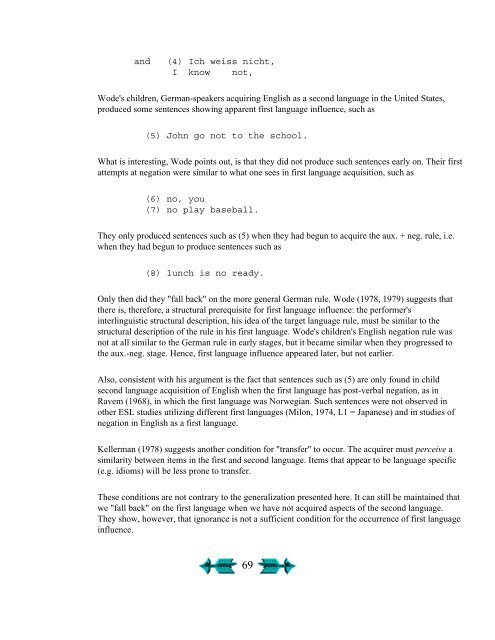Second Language Acquisition and Second ... - Stephen Krashen
Second Language Acquisition and Second ... - Stephen Krashen
Second Language Acquisition and Second ... - Stephen Krashen
You also want an ePaper? Increase the reach of your titles
YUMPU automatically turns print PDFs into web optimized ePapers that Google loves.
<strong>and</strong> (4) Ich weiss nicht,<br />
I know not,<br />
Wode's children, German-speakers acquiring English as a second language in the United States,<br />
produced some sentences showing apparent first language influence, such as<br />
(5) John go not to the school.<br />
What is interesting, Wode points out, is that they did not produce such sentences early on. Their first<br />
attempts at negation were similar to what one sees in first language acquisition, such as<br />
(6) no, you<br />
(7) no play baseball.<br />
They only produced sentences such as (5) when they had begun to acquire the aux. + neg. rule, i.e.<br />
when they had begun to produce sentences such as<br />
(8) lunch is no ready.<br />
Only then did they "fall back" on the more general German rule. Wode (1978, 1979) suggests that<br />
there is, therefore, a structural prerequisite for first language influence: the performer's<br />
interlinguistic structural description, his idea of the target language rule, must be similar to the<br />
structural description of the rule in his first language. Wode's children's English negation rule was<br />
not at all similar to the German rule in early stages, but it became similar when they progressed to<br />
the aux.-neg. stage. Hence, first language influence appeared later, but not earlier.<br />
Also, consistent with his argument is the fact that sentences such as (5) are only found in child<br />
second language acquisition of English when the first language has post-verbal negation, as in<br />
Ravem (1968), in which the first language was Norwegian. Such sentences were not observed in<br />
other ESL studies utilizing different first languages (Milon, 1974, L1 = Japanese) <strong>and</strong> in studies of<br />
negation in English as a first language.<br />
Kellerman (1978) suggests another condition for "transfer" to occur. The acquirer must perceive a<br />
similarity between items in the first <strong>and</strong> second language. Items that appear to be language specific<br />
(e.g. idioms) will be less prone to transfer.<br />
These conditions are not contrary to the generalization presented here. It can still be maintained that<br />
we "fall back" on the first language when we have not acquired aspects of the second language.<br />
They show, however, that ignorance is not a sufficient condition for the occurrence of first language<br />
influence.<br />
69











